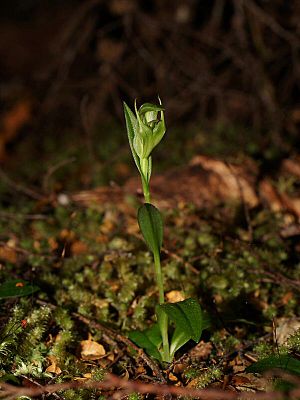Rough greenhood facts for kids
Quick facts for kids Rough greenhood |
|
|---|---|
 |
|
| Pterostylis scabrida growing near the Rapid River in Tasmania | |
| Scientific classification | |
| Genus: |
Pterostylis
|
| Species: |
scabrida
|
The rough greenhood (Pterostylis scabrida) is a special type of orchid that grows only in Tasmania, Australia. This plant has a bunch of leaves at its base. It also grows a single green and white flower on a stem that feels a bit rough. You can find rough greenhoods in many wet forests, even in rainforests, which is quite rare for this type of orchid.
Contents
What the Rough Greenhood Looks Like
The rough greenhood is a plant that grows on land, not on other plants. It is a perennial plant, meaning it lives for more than two years. It's also deciduous, so its leaves fall off at certain times. This plant is a herb, which means it has soft stems, not woody ones like trees.
Under the ground, it has a tuber, which is like a small, round storage part. From this tuber, a group of dark green leaves grows in a circle, like a rosette. These leaves are usually 30–60 mm long and 8–10 mm wide.
A single green and white flower grows on a rough stem that can be 80–250 mm tall. The flower itself is about 20–25 mm long and 14–16 mm wide.
Flower Parts
The flower has some unique parts:
- The top part of the flower, called the dorsal sepal, and the petals are joined together. They form a hood, or "galea," over the central part of the flower called the column.
- The dorsal sepal is the same length as the petals and bends forward with a pointy tip.
- There's a big space between this hood and the two lower parts, called the lateral sepals.
- The lateral sepals stand upright and have thin, thread-like tips that are 14–16 mm long. Between them, there's a slightly bumpy, V-shaped dip called a sinus.
- The labellum is a special part of the flower that looks like a tongue. It's brown, curved, and sticks out above the V-shaped dip. It's about 12–15 mm long and 3 mm wide.
Rough greenhoods usually bloom, or flower, from October to February.
How it Got its Name
The rough greenhood was first officially described in 1840 by a person named John Lindley. He wrote about it in his book, The Genera and Species of Orchidaceous Plants.
The second part of its scientific name, scabrida, comes from a Latin word. It means "rough" or "rugged," which describes the feel of its stem.
Where the Rough Greenhood Lives
You can find the rough greenhood all over Tasmania. It's quite common and grows in wet forests, including special areas called rainforests. It's one of the few Pterostylis orchids that can grow in rainforests.

